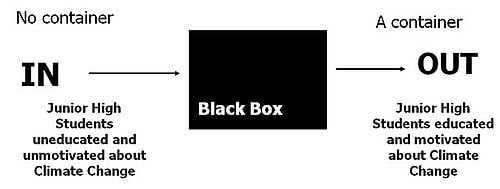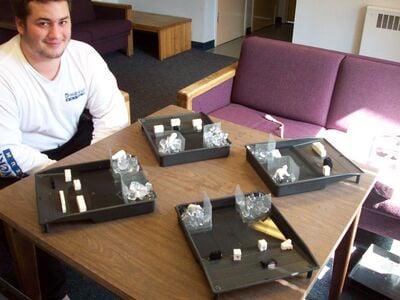Cbcoutinho (talk | contribs) |
Cbcoutinho (talk | contribs) (Undo revision 125575 by Cbcoutinho (Talk)) |
||
| Line 19: | Line 19: | ||
|- | |- | ||
| Durability | | Durability | ||
| 9 | |align="center"| 9 | ||
| Must last one year with weekly use | | Must last one year with weekly use | ||
|- | |- | ||
| Safety | | Safety | ||
| 10 | |align="center"| 10 | ||
| Doesn’t harm users or viewers | | Doesn’t harm users or viewers | ||
|- | |- | ||
| Educational Value | | Educational Value | ||
| 9 | |align="center"| 9 | ||
| Gives students as much education as possible while meeting California educational standards | | Gives students as much education as possible while meeting California educational standards | ||
|- | |- | ||
| Cost | | Cost | ||
| 5 | |align="center"| 5 | ||
| As cheap as possible within our $325 budget ($75 per team member and $100 from the RCEA) | | As cheap as possible within our $325 budget ($75 per team member and $100 from the RCEA) | ||
|- | |- | ||
| Level of Fun | | Level of Fun | ||
| 7 | |align="center"| 7 | ||
| As fun as possible for age group | | As fun as possible for age group | ||
|- | |- | ||
| Age Appropriate | | Age Appropriate | ||
| 7 | |align="center"| 7 | ||
| Targets middle school children | | Targets middle school children | ||
|- | |- | ||
| Ease of use | | Ease of use | ||
| 8 | |align="center"| 8 | ||
| Less than 15-20 minute set up time per use | | Less than 15-20 minute set up time per use | ||
|- | |- | ||
| Ease of maintenance | | Ease of maintenance | ||
| 8 | |align="center"| 8 | ||
| Less than 15-20 minute clean up time per use | | Less than 15-20 minute clean up time per use | ||
|- | |- | ||
| Line 68: | Line 68: | ||
|- | |- | ||
| Gas | | Gas | ||
| $ 44.58 | |||
|- | |- | ||
| Polar Bear | | Polar Bear | ||
| $ 3.87 | |||
|- | |- | ||
| Plastic Paint Trays | | Plastic Paint Trays | ||
| $ 8.68 | |||
|- | |- | ||
| Metal Screen | | Metal Screen | ||
| $ 6.50 | |||
|- | |- | ||
| Popsicle sticks | | Popsicle sticks | ||
| $ .40 | |||
|- | |- | ||
| Spray Paint | | Spray Paint | ||
| $ 21.36 | |||
|- | |- | ||
| Nippy Cutter | | Nippy Cutter | ||
| $ 6.53 | |||
|- | |- | ||
| Food for thought | | Food for thought | ||
| $ 6.03 | |||
|- | |- | ||
| Pitcher | | Pitcher | ||
| $ 5.99 | |||
|- | |- | ||
| Epoxy | | Epoxy | ||
| $ 21.94 | |||
|- | |- | ||
Revision as of 19:39, 7 May 2010
Introduction
The Seas of Change project models the process of global climate change melting polar ice caps and raising sea levels that will eventually cover cities and destroy polar bear habitat.
Background
The Spring 2010 Engineering 215 Introduction to Design class, as part of the Environmental Resources Engineering program located at Humboldt State University and taught by Lonny Grafman, took upon a project issued by the Redwood Coast Energy Authority for engineering students to create a reusable model that can be used by teachers to teach students about either climate change, energy conservation, or renewable energy. The Seas of Change project was created by Alex Albin, Chris Coutinho, and Britlandt Abney.
Objective
The objective of our project entails the creation of a model that educates a specified age group about the effects of and possible solutions to climate change. The research we conducted to our specified age group and the problem of climate change itself has aided in the construction of this model. We hope that in the time following the construction of this project, the children will be more aware of the problem of climate change and be more motivated to make positive changes in the world around them.

Criteria
Design Solution
Our solution consisted of two of our alternate solutions discussed in section three. Our most successful solution according to the assigned criterion ended up being “The Seas of Change”. This solution involved ice melting in a water container and overflowing a model town just next to the original sea level. As the ice melts in the warmed water the level would rise and destroy/flood the model town along the shoreline created. This idea has been combined with our Polar Bear idea from the alternate solutions section. This solution consisted of a model polar bear drowning in a sea as the ice cube he stands upon melts in the warmed water. Both solutions have warm water as well as ice cubes so the combination of the two solutions was a relatively easy one.
Due to the combination of solutions and changes that arose during supply purchasing the final solution has undergone a few changes. The model now has four trays so that more students may be involved in the project. A rotating heat lamp in the middle will represent the sun and provide some heat for the four trays surrounding it. Each tray will have trapped sections of crushed ice in the corners representing the globe’s polar ice caps along with a model town along an elevated shore. In addition a polar bear will be sitting on top of one of the ice caps in each tray. Warm water will be poured into each tray up to the shore level to represent normal sea levels. As the warm water melts the ice caps the water level will rise. This will result in the polar bear being submersed in the water as well as the coastal town being flooded. The design will metaphorically yet accurately represent several of the damaging effects of global warming, including rising seas, animal migration habits being altered, and warming sea waters.

Design Costs
| Criteria | Weight | Description |
|---|---|---|
| Durability | 9 | Must last one year with weekly use |
| Safety | 10 | Doesn’t harm users or viewers |
| Educational Value | 9 | Gives students as much education as possible while meeting California educational standards |
| Cost | 5 | As cheap as possible within our $325 budget ($75 per team member and $100 from the RCEA) |
| Level of Fun | 7 | As fun as possible for age group |
| Age Appropriate | 7 | Targets middle school children |
| Ease of use | 8 | Less than 15-20 minute set up time per use |
| Ease of maintenance | 8 | Less than 15-20 minute clean up time per use |
| Item | Cost |
|---|---|
| Gas | $ 44.58 |
| Polar Bear | $ 3.87 |
| Plastic Paint Trays | $ 8.68 |
| Metal Screen | $ 6.50 |
| Popsicle sticks | $ .40 |
| Spray Paint | $ 21.36 |
| Nippy Cutter | $ 6.53 |
| Food for thought | $ 6.03 |
| Pitcher | $ 5.99 |
| Epoxy | $ 21.94 |